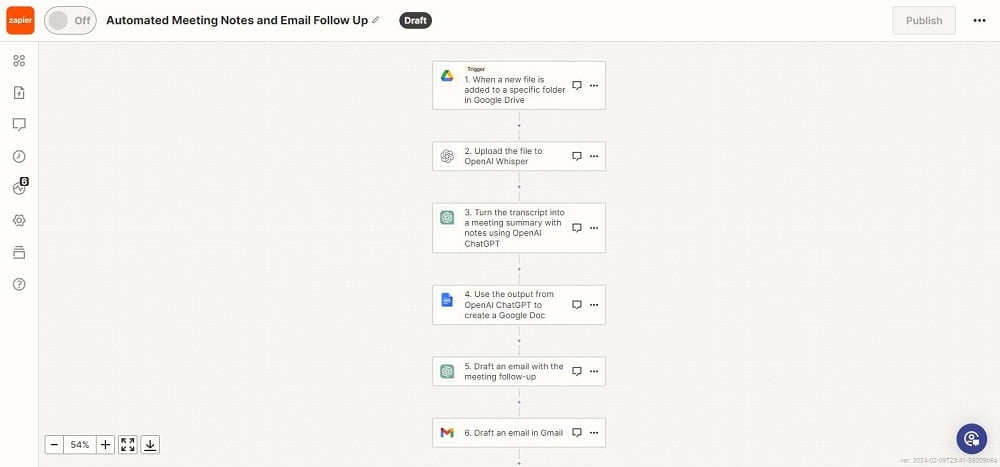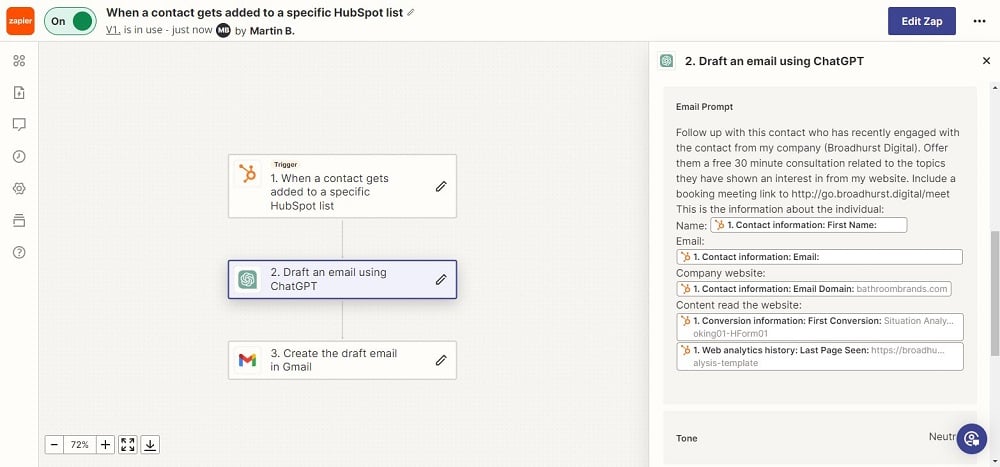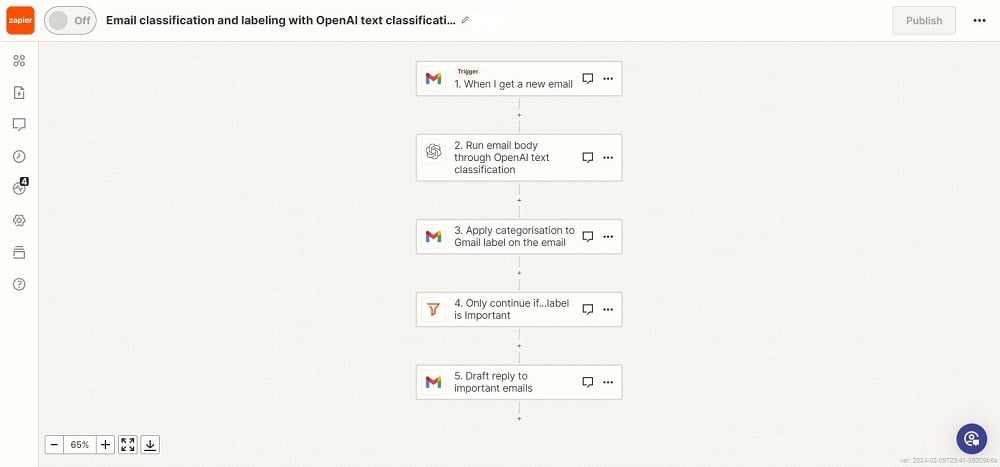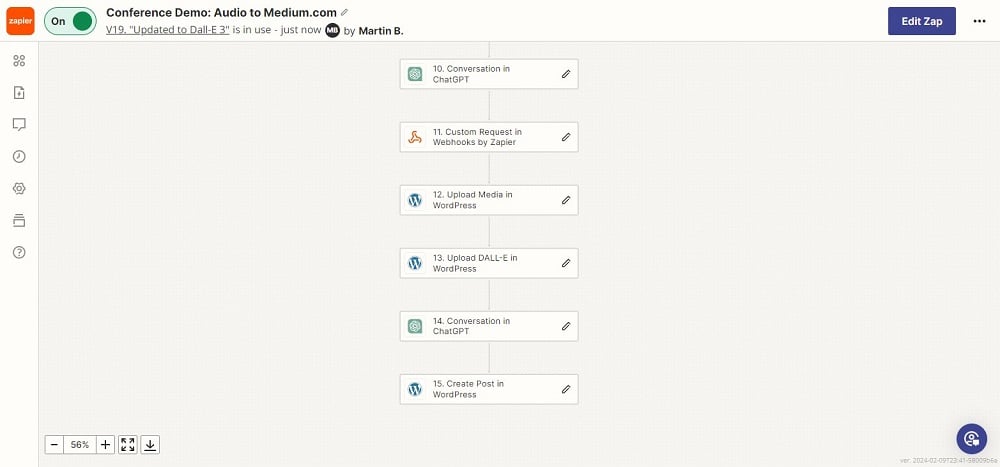Integrating ChatGPT with Zapier allows for the automation of tasks that would otherwise require significant manual effort, thereby freeing up valuable resources and enabling employees to focus on more strategic tasks. The versatility of ChatGPT, when combined with Zapier’s ability to connect different apps and services, creates a powerful toolset for businesses looking to enhance their productivity and efficiency. Through the following use cases, we will illustrate how these integrations can transform your business processes, making them more effective and streamlined.
As businesses embark on the journey of integrating AI and automation technologies like ChatGPT and Zapier, understanding the broader strategic considerations is key to maximising their impact. Our detailed exploration in 'Top Considerations for Executives Planning for Generative AI' cover the essential aspects executives need to consider when planning the integration of generative AI into their strategies.
1. Data Cleansing and CRM Integration

The first use case addresses the common issue of inconsistent data quality in lead generation forms. Integrating ChatGPT with Zapier allows businesses to automatically cleanse and standardise this data before it enters their CRM system. This process ensures that names, job titles, and other critical information are formatted uniformly, facilitating better data management and personalisation efforts. For example, ChatGPT can be programmed to convert all names to title case and expand abbreviated job titles, thereby enhancing the accuracy and usability of CRM data.
This standardisation is crucial for effective segmentation and personalisation in marketing and sales efforts. When data is consistent, it’s easier to identify and target specific groups within your database, improving the effectiveness of your campaigns. Moreover, personalising communications with correctly formatted names and titles can significantly increase engagement rates, as recipients are more likely to respond positively to messages that appear tailored to them.
Implementing this integration not only improves the quality of your data but also streamlines the process of data entry into your CRM. By automating data cleansing, businesses can reduce manual errors and ensure that their CRM systems are populated with high-quality, actionable data. This, in turn, can lead to more effective marketing strategies, improved customer relations, and increased sales opportunities, demonstrating the tangible benefits of integrating ChatGPT with Zapier for data management.
2. Automated Meeting Notes Assistant
The ability to efficiently capture and summarise the key points from meetings is invaluable for businesses. By connecting ChatGPT with audio recordings through Zapier, companies can automate the creation of meeting summaries and action items. This process begins with recording the audio of a meeting, which is then uploaded to a designated folder. Zapier detects the new file and triggers the transcription process using OpenAI’s Whisper model. Following transcription, ChatGPT processes the text to generate concise summaries and actionable follow-up tasks.

This automation saves significant time and effort, eliminating the need for manual note-taking and transcription. It ensures that important details and action points are accurately captured and easily accessible, facilitating better communication and follow-up among team members. Furthermore, this approach is not limited to internal meetings; it can be applied to conference talks and other events, enabling businesses to capture and leverage insights from various sources without the need for exhaustive note-taking.
The flexibility of this use case extends to the customisation of summaries and action items based on specific business needs. Companies can tailor ChatGPT prompts to highlight particular types of information, such as decisions made, tasks assigned, or insights gained. This level of customisation ensures that the automated meeting notes are directly relevant and immediately useful, further enhancing the productivity and efficiency benefits of integrating ChatGPT with Zapier.
3. Personalised Sales Outreach

Drafting personalised sales outreach emails can be a complex and time-consuming task, particularly when trying to incorporate detailed insights from a CRM or marketing automation platform. The integration of ChatGPT and Zapier simplifies this process by automating the creation of customised sales emails. By pulling data on leads’ interactions with your content, ChatGPT can craft messages that directly address the interests and needs of each recipient, increasing the likelihood of engagement.
This approach leverages the rich data available in your CRM, such as email interactions, webpage visits, and content engagement, to personalise outreach efforts. ChatGPT analyses this data to identify key areas of interest for each lead, ensuring that the sales emails are not only personalised but also highly relevant. This relevance is critical for standing out in a crowded inbox and making a meaningful connection with potential customers.
The efficiency of this use case is further enhanced by the ability to automate the insertion of these personalised emails into the drafts folder of your email client. This streamlines the outreach process, allowing sales teams to review and send tailored messages with minimal effort. The integration thus enables a more effective and efficient sales process, combining the personal touch of customised communication with the convenience and speed of automation.
4. Email Sorting Assistant

Managing a cluttered inbox is a common challenge for professionals across industries. The integration of ChatGPT and Zapier offers a solution by automating the sorting and categorisation of emails. Users can define specific criteria or labels for emails, and Zapier can trigger ChatGPT to process and categorise incoming messages accordingly. This can include drafting responses for certain types of emails, such as enquiries or event invitations, streamlining the email management process.
This automation not only saves time but also ensures that important emails are promptly addressed while less critical messages are dealt with appropriately. By automating the categorisation and initial response drafting, professionals can focus their attention on emails that require their direct input, improving overall productivity. Additionally, this system can be refined over time to accommodate new email types and responses, making it a flexible solution to the ever-evolving challenge of email management.
The personal assistant-like capabilities of this integration extend beyond simple sorting and responding. For instance, it can prioritise emails based on urgency or sender importance, suggest follow-up actions, and even schedule appointments directly from email requests. This level of automation transforms email management from a time-consuming task into an efficient process, enabling professionals to better manage their time and focus on more strategic activities.
5. Automatically Published Blog Posts
Creating content, particularly in the form of blog posts, is essential for many businesses but can be resource-intensive. The combination of ChatGPT and Zapier offers a streamlined solution by converting audio recordings into structured, well-written blog posts. This process begins with the user recording their thoughts or insights, which are then transcribed and processed by ChatGPT into a coherent article. Zapier facilitates the workflow by moving data between services, including uploading the final text to a blogging platform, ready for publication.

This use case not only accelerates the content creation process but also opens up new possibilities for content generation. For instance, businesses can quickly turn speeches, interviews, or informal discussions into blog posts, expanding their content library with minimal effort. While the potential for fully automated publishing is enticing, it’s advisable to include a step for human review to ensure the content meets quality standards and accurately represents the brand.
The multi-step workflow exemplified in this use case demonstrates the power of combining AI with automation tools like Zapier. By handling tasks from transcription to drafting to image creation and eventual publication, this integration can significantly reduce the time and effort required to produce and publish content. However, as with all automated processes, a balance between efficiency and oversight is crucial to maintaining quality and relevance in the content produced. It is not recommended that you ACTUALLY publish a blog post without any human oversight.
Conclusion
The integration of ChatGPT with Zapier presents a wide array of opportunities for businesses to enhance their operational efficiency and productivity. Through the five use cases outlined above, it’s clear that this combination can significantly impact various aspects of business operations, from data management and meeting documentation to personalised communication and content creation. By automating routine tasks and streamlining workflows, businesses can allocate their resources more effectively, focusing on strategic growth and innovation.
As the digital landscape continues to evolve, the adoption of AI and automation technologies like ChatGPT and Zapier will become increasingly important for maintaining a competitive edge. These tools not only offer practical solutions to common business challenges but also enable organisations to explore new ways of working and engaging with their customers. By embracing these technologies, businesses can unlock their full potential, achieving greater efficiency, productivity, and success in the digital age.

Comments